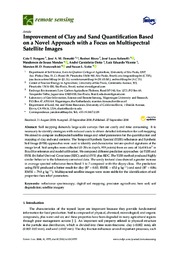Improvement of clay and sand quantification based on a novel approach with a focus on multispectral satellite images.
Improvement of clay and sand quantification based on a novel approach with a focus on multispectral satellite images.
Author(s): FONGARO, C. T.; DEMATTÊ, J. A. M.; RIZZO, R.; SAFANELLI, J. L.; MENDES, W. de S.; DOTTO, A. C.; VICENTE, L. E.; FRANCESCHINI, M. H. D.; USTIN, S. L.
Summary: Abstract: Soil mapping demands large-scale surveys that are costly and time consuming. It is necessary to identify strategies with reduced costs to obtain detailed information for soil mapping. We aimed to compare multispectral satellite image and relief parameters for the quantification and mapping of clay and sand contents. The Temporal Synthetic Spectral (TESS) reflectance and Synthetic Soil Image (SYSI) approaches were used to identify and characterize texture spectral signatures at the image level. Soil samples were collected (0?20 cm depth, 919 points) from an area of 14,614 km 2 in Brazil for reference and model calibration. We compared different prediction approaches: (a) TESS and SYSI; (b) Relief-Derived Covariates (RDC); and (c) SYSI plus RDC. The TESS method produced highly similar behavior to the laboratory convolved data. The sandy textural class showed a greater increase in average spectral reflectance from Band 1 to 7 compared with the clayey class. The prediction using SYSI produced a better result for clay (R 2 = 0.83; RMSE = 65.0 g kg − 1 ) and sand (R 2 = 0.86; RMSE = 79.9 g kg − 1 ). Multispectral satellite images were more stable for the identification of soil properties than relief parameters.
Publication year: 2018
Types of publication: Journal article
Unit: Embrapa Environment
Observation
Some of Embrapa's publications are published as ePub files. To read them, use or download one of the following free software options to your computer or mobile device. Android: Google Play Books; IOS: iBooks; Windows and Linux: Calibre.
Access other publications
Access the Agricultural Research Database (BDPA) to consult Embrapa's full library collection and records.
Visit Embrapa Bookstore to purchase books and other publications sold by Embrapa.

